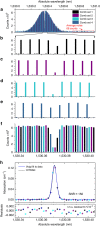The optical frequency comb fibre spectrometer
- PMID: 27694981
- PMCID: PMC5063959
- DOI: 10.1038/ncomms12995
The optical frequency comb fibre spectrometer
Abstract
Optical frequency comb sources provide thousands of precise and accurate optical lines in a single device enabling the broadband and high-speed detection required in many applications. A main challenge is to parallelize the detection over the widest possible band while bringing the resolution to the single comb-line level. Here we propose a solution based on the combination of a frequency comb source and a fibre spectrometer, exploiting all-fibre technology. Our system allows for simultaneous measurement of 500 isolated comb lines over a span of 0.12 THz in a single acquisition; arbitrarily larger span are demonstrated (3,500 comb lines over 0.85 THz) by doing sequential acquisitions. The potential for precision measurements is proved by spectroscopy of acetylene at 1.53 μm. Being based on all-fibre technology, our system is inherently low-cost, lightweight and may lead to the development of a new class of broadband high-resolution spectrometers.
Figures








References
-
- Diddams S. A. et al.. Direct link between microwave and optical frequencies with a 300 THz femtosecond laser comb. Phys. Rev. Lett. 84, 5102–5105 (2000). - PubMed
-
- Jones D. J. et al.. Carrier-envelope phase control of femtosecond modelocked lasers and direct optical frequency synthesis. Science 288, 635–639 (2000). - PubMed
-
- Baltuska A. et al.. Attosecond control of electronic processes by intense light fields. Nature 421, 611–615 (2003). - PubMed
-
- Cundiff S. T. & Weiner A. M. Optical arbitrary waveform generation. Nat. Photonics 4, 760–766 (2010).
-
- Rieker G. B. et al.. Frequency-comb-based remote sensing of greenhouse gases over kilometer air paths. Optica 1, 290–298 (2014).
Publication types
LinkOut - more resources
Full Text Sources
Other Literature Sources

